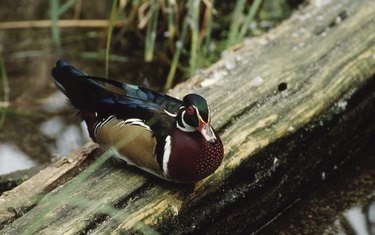
Polycrylic, manufactured by the Minwax company, is an interesting clear coat for wood. Polycrylic is water soluble, nonflammable and odor free. It is environmentally friendly, and you can use it indoors. Uncured polycrylic cleans up with soap and water. However, once dry it is impervious to water, becoming a durable clear finish. The answer to whether you can apply Polycrylic by spraying is yes and no. According to the Minwax company, it depends on how you originally obtained the Polycrylic.
Minwax Recommendation
Video of the Day
Polycrylic comes in three gloss levels: Gloss, semigloss and satin. Gloss produces a high "wet-look" shine, whereas semigloss and satin produce satin sheens. Minwax recommends stirring the finish before and during use, and not shaking. Minwax further recommends you use a soft synthetic-bristle brush to apply the finish in thin coats. After each coat dries, sand with fine 220-grit sandpaper. Clean off all dust. Apply the next coat, and repeat the coating process. Three coats should be sufficient. The Minwax company cautions against using steel wool to smooth down coats. Don't thin the finish.
Video of the Day
Aerosol Can
Polycrylic is available in an aerosol can. This is specially formulated for spraying. It is available in gloss, semigloss and satin. This is the only spray form of Polycrylic available straight from the Minwax company. As with all spray operations, its best to apply thin coats and allow them to dry thoroughly, and lightly sand before applying another coat. Also, as with all spraying operations, wear a respirator to avoid inhalation of fumes.
Experimentation
You can experiment with spraying Polycrylic, but thinning is not recommended by Minwax. If you try to use a spray gun such as those used for automotive finishes, it may shoot the finish out at too high a velocity, leading to spattering instead of adhesion. if you still wish to experiment, use a clean spray bottle with a squeeze trigger. This will spray the polycrylic out at a low pressure with a fine mist. Again, this may or may not work, since Minwax recommends a soft-bristle brush only. Experiment on scrap wood first to determine if the spray process works correctly for you. Keep in mind it's a milky white substance when wet; as it dries, it turns clear.
Clean Up
Minwax suggests cleaning tools with soap and water for wet, uncured Polycrylic. Do not allow it to dry on your tools. Its impervious to water when dry. You have to use harsh solvents or paint strippers to remove dried residue. The solvents themselves may dissolve the bristles of your brush. Have a bucket of water with dissolved soap handy, and wash your tools in the water as soon as you are done using them. After you thoroughly wash the tools, rinse them with running water.